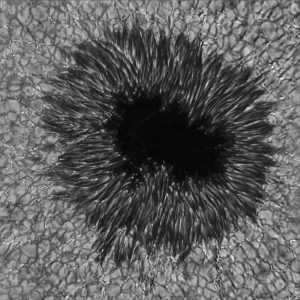On February 2nd 2017, Dr. Giorgio Viavattene presented his thesis entitled “Spectro-polarimetric analysis of a short lived solar active region” in front of the Tor Vergata Solar and Space Physics Group.
He has recently started the PhD in Astronomy, Astrophysics and Space Science in the joint program Sapienza – Tor Vergata – INAF, joining the Group of Solar Physics of “Tor Vergata” University and having PhD Dario Del Moro, as supervisor, and Dr. Giuseppe Consolini and PhD Luca Giovannelli, as co-supervisors. During the thesis he will study the “Magnetic fields and the dynamics of the solar convection”, doing both spectro-polarimetric analysis and developing new solar instrumentation, especially Fabry-Perot interferometers.
Here an abstract of his Master Thesis:
Magnetic fields play a crucial role in the formation and evolution of solar active regions and they regulate the whole cycle of solar activity. The processes of formation, evolution and disappearance of the active regions have some aspects that are not yet entirely clear because of the difficulty inherent in the observation of these phenomena, which require the use of large diameter solar telescopes with their suite of spectropolarimetric instruments.
This thesis, supervised by Professor Francesca Zuccarello, was carried out taking advantage of the international mobility offered by the Catania University’s curricular training abroad, so that part of the thesis work was carried out during the three months spent at Instituto de Astrofisica de Canarias, having Professor Manuel Collados Vera and Professor Basilio Ruiz Cobo as co-supervisors.
In the first part of the thesis, the theory of radiative transfer for the polarized radiation is discussed in depth, describing the characteristics of polarization of light, the normal and anomalous Zeeman effect, and how to perform the measurement of polarized radiation using some optical devices and the prototype polarimeter. This first part is concluded focusing the attention on the solution of the radiative transfer equation in the Milne-Eddington approximation.
Thereafter, the various methods to solve the radiative transfer equation are analyzed, describing the formal solution, the theory of the response functions and how to solve the inversion problem of Stokes profiles using the Levenberg-Marquardt algorithm and defining a merit function.
After studying all the theory, an IDL code for the synthesis and inversion of the Stokes profiles in the Milne-Eddington approximation was developed by the writer. The MESISP (Milne-Eddington Synthesis and Inversion of Stokes Profiles) code, starting from atmospheric parameters, synthesizes the emerging Stokes profiles (synthesis); or, vice-versa, starting from the observed Stokes profiles, it provides an estimation of the atmospheric parameters of the plasma element that generated the polarized radiation (inversion). To prove the functionality of the code, various tests and a Monte Carlo simulation were performed. Soon after, the attention is moved on the study and use of the SIR (Stokes Inversion based on Response function) code, which, compared to a simple Milne-Eddington code, allows the user also to get information on the stratification of the atmospheric parameters in the emitting plasma element. A series of tests were carried out between the two synthesis and inversion codes.
The experimental part of this thesis took place during an observing campaign (from the 27th of May to the 3rd of June 2016) at the GREGOR solar telescope, at the Teide Observatory, and later analyzing the data acquired.
An entire chapter is devoted to the description of the optical design, building, dome, adaptive optics and the instruments of the GREGOR solar telescope. This is equipped with BBI (Broad Band Imager), GRIS (GRating Infrared Spectrograph) and GFPI (GREGOR Fabry-Perot Interferometer) in order to perform spectro-polarimetric observations with high spatial (80 km on the solar surface), temporal (seconds) and spectral resolution (R = 300000).
Once acquired with the GRIS instrument the scans of the pores of the active region NOAA 12549, the calibration of the data was performed, and the various steps are described in Chapter 6. After describing the characteristics of the datasets, the preliminary data reduction operations are discussed, i.e. the subtraction of dark images, the division by the flat-field images and correction of polarimetric effects introduced by the telescope. Hereinafter the procedure of rectification of the continuum and the calibration in wavelengths are illustrated. Finally the datasets acquired during the observing campaign are presented.
In the final part, the data analysis is extensively discussed, presenting maps and graphics of the obtained results. After describing the inversion strategy and the inversion of the calibrated datasets, the results are discussed, focusing on the evolution of the observed active region, the presence of moving magnetic features (MMFs), the LOS velocity in the colder regions of the pores, a particular effect in the pixels around the granules and the effects of the contamination of data due to stray light.
The thesis work is concluded by discussing possible future developments in this field of research.




More Stories
Stage a Tor Vergata: Summer 2019
A night at the University.
ESCAPE Project Press Release